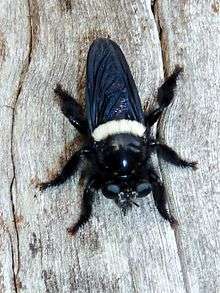Laphriinae
Laphriinae is a subfamily of robber flies in the family Asilidae. There are more than 110 genera and 1,000 described species in Laphriinae.[1][2][3][4] Larvae of the genus Hyperechia are known to grow inside the cells of Xylocopa bees, feeding on their larvae.[5]
.jpg)
Smeryngolaphria numitor

Atomosia melanopogon
| Laphriinae | |
|---|---|
 | |
| Hyperechia marshalli | |
| Scientific classification | |
| Kingdom: | Animalia |
| Phylum: | Arthropoda |
| Class: | Insecta |
| Order: | Diptera |
| Family: | Asilidae |
| Subfamily: | Laphriinae |
Laphriinae genera
Genera in the subfamily include:
- Acrochordomerus Hermann, 1920
- Adelodus Hermann, 1912
- Afromelittodes Oldroyd and Bruggen, 1963
- Afromosia Londt, 2015
- Amathomyia Hermann, 1912
- Andrenosoma Rondani, 1856
- Anoplothyrea Meijere, 1914
- Anypodetus Hermann, 1908
- Aphestia Schiner, 1866
- Aphistina Oldroyd, 1972
- Aphractia Artigas and Papavero and Serra, 1991
- Apoxyria Schiner, 1866
- Asicya Lynch Arribálzaga, 1880
- Atomosia Macquart, 1838
- Atomosiella Wilcox, 1937
- Atoniomyia Hermann, 1912
- Atractia Macquart, 1838
- Bathropsis Hermann, 1912
- Borapisma Hull, 1957
- Bromotheres Hull, 1962
- Cenochromyia Hermann, 1912
- Cerotainia Schiner, 1868
- Cerotainiops Curran, 1930
- Choerades Walker, 1851
- Chrysotriclis Artigas and Papavero and Costa, 1995
- Chymedax Hull, 1958
- Clariola Kertész, 1901
- Cochleariocera Artigas and Papavero and Costa, 1995
- Cormansis Walker, 1851
- Cryptomerinx Enderlein, 1914
- Ctenota Loew, 1873
- Cyanonedys Hermann, 1912
- Cymbipyga Artigas and Papavero and Costa, 1995
- Cyphomyiactia Artigas and Papavero and Serra, 1991
- Dasylechia Williston, 1907
- Dasyllina Bromley, 1935
- Dasyllis Loew, 1851
- Dasythrix Loew, 1851
- Despotiscus Bezzi, 1928
- Dichaetothyrea Meijere, 1914
- Dissmeryngodes Hermann, 1912
- Epaphroditus Hermann, 1912
- Ericomyia Londt, 2015
- Eumecosoma Schiner, 1866
- Gerrolasius Hermann, 1920
- Glyphotriclis Hermann, 1920
- Goneccalypsis Hermann, 1912
- Gymnotriclis Artigas and Papavero and Costa, 1995
- Helolaphyctis Hermann, 1920
- Hexameritia Speiser, 1920
- Hodites Hull, 1962
- Hoplistomerus Macquart, 1838
- Hoplotriclis Hermann, 1920
- Hybozelodes Hermann, 1912
- Hyperechia Schiner, 1866
- Ichneumolaphria Carrera, 1951
- Joartigasia Martinez and Martinez, 1974
- Katharma Oldroyd, 1959
- Katharmacercus Tomasovic, 2014
- Lampria Macquart, 1838
- Lamprozona Loew, 1851
- Lamyra Loew, 1851
- Laphria Meigen, 1803 (bee-like robber flies)
- Laphygmolestes Hull, 1962
- Laphyctis Loew, 1858
- Laphystia Loew, 1847
- Laphystotes Oldroyd, 1974
- Laxenecera Macquart, 1838
- Loewinella Hermann, 1912
- Lycosimyia Hull, 1958
- Macahyba Carrera, 1947
- Mactea Richter and Mamaev, 1976
- Maira Schiner, 1866
- Martinomyia Özdikmen, 2006
- Nannolaphria Londt, 1977
- Neophoneus Williston, 1889
- Notiolaphria Londt, 1977
- Nusa Walker, 1851
- Nyximyia Hull, 1962
- Oidardis Hermann, 1912
- Opeatocerus Hermann, 1912
- Opocapsis Hull, 1962
- Orthogonis Hermann, 1914
- Pagidolaphria Hermann, 1914
- Perasis Hermann, 1906
- Phellopteron Hull, 1962
- Pilica Curran, 1931
- Pilophoneus Londt, 1988
- Pogonosoma Rondani, 1856
- Proagonistes Loew, 1858
- Protometer Artigas and Papavero and Costa, 1995
- Prytanomyia Özdikmen, 2006
- Pseudonusa Joseph and Parui, 1989
- Psilocurus Loew, 1874
- Rhathimomyia Lynch Arribálzaga, 1882
- Scytomedes Röder, 1882
- Smeryngolaphria Hermann, 1912
- Stiphrolamyra Engel, 1928
- Storthyngomerus Hermann, 1919
- Strombocodia Hermann, 1912
- Systropalpus Hull, 1962
- Torebroma Hull, 1957
- Tricella Daniels, 1975
- Trichardis Hermann, 1906
- Trichardopsis Oldroyd, 1958
- Triclioscelis Roeder, 1900
- Triclis Loew, 1851
- Udenopogon Becker in Becker and Stein, 1913
- Zabrops Hull, 1957
- † Laloides Oldroyd, 1972
- † Laphyctis Loew, 1858
- † Protoloewinella Schumann, 1984
- † Rhopalogaster Macquart, 1834
gollark: Like how in theory on arbitrarily big numbers the fastest way to do multiplication is with some insane thing involving lots of Fourier transforms, but on averagely sized numbers it isn't very helpful.
gollark: It's entirely possible that the P = NP thing could be entirely irrelevant to breaking encryption, actually, as it might not provide a faster/more computationally efficient algorithm for key sizes which are in use.
gollark: Well, that would be inconvenient.
gollark: Increasing the key sizes a lot isn't very helpful if it doesn't increase the difficulty of breaking it by a similarly large factor.
gollark: I'm not sure what P = NP would mean for that. Apparently doing that is non-polynomial time, and a constructive P = NP proof would presumably let you construct a polynomial-time algorithm.
References
- "Laphriinae Report". Integrated Taxonomic Information System. Retrieved 2019-06-03.
- "Laphriinae subfamily Information". BugGuide.net. Retrieved 2019-06-03.
- Dikow, Torsten (2019). "Asiloid Flies, deciphering their diversity and evolutionary history". National Museum of Natural History of the Smithsonian Institution. Retrieved 2019-06-03.
- Laphriinae. Fauna Europaea.
- Poulton, Edward B. (1924). "VI. The relation between the larvae of the Asilid genus Hyperechia (Laphriinae) and those of Xylocopid bees". Transactions of the Royal Entomological Society of London. 72 (1–2): 121–133. doi:10.1111/j.1365-2311.1924.tb03352.x.
Further reading
- Dikow, T. (2009). "Phylogeny of Asilidae inferred from morphological characters of imagines (Insecta, Diptera, Brachycera, Asiloidea)". Bulletin of the American Museum of Natural History (319). hdl:2246/5949. ISSN 0003-0090.
- Geller-Grimm, Fritz (2004). "A world catalogue of the genera of the family Asilidae (Diptera)". Studia Dipterologica. 10.
- Hull, F. M. (1962). "Robber flies of the world". Bulletin of the United States National Museum. 224. doi:10.5479/si.03629236.224. hdl:10088/10126.
- McAlpine, J. F.; Petersen, B. V.; Shewell, G. E.; Teskey, H. J.; Vockeroth, J. R.; Wood, D. M., eds. (1981). Manual of Nearctic Diptera, Volume I. Agriculture Canada, Research Branch. ISBN 978-0-660-10731-8.
External links

This article is issued from Wikipedia. The text is licensed under Creative Commons - Attribution - Sharealike. Additional terms may apply for the media files.